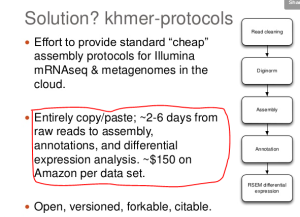
What is the True Computing Cost of RNAseq Analysis? - Titus Brown's Slides
Titus Brown posted nice set of slides with complete protocols for RNAseq and Metagenome analysis (see below), but let us get to the part that we find the most valuable. He made honest estimate of time and cost for bioinformatic analysis and came to the numbers shown in the following figure. We confirmed with him that the estimate of $150 is meant to be for per sample, and not the entire experiment.

Why do we stress on honest estimate? Biologists have good understanding of experimental cost, which is usually given by adding the prices of kits/reagents, lab-space (comes as overhead), personnel and depreciated large equipments. An wide range of experimental service providers benchmarked those costs and offer ‘standard prices’ for sequencing/lane. Any service provider, who significantly underestimates the cost, usually either provides low quality service or goes out of business.
The cost of computing, on the other hand, is often grossly under-estimated, because many small and infrequent tasks are often assumed to be cost-free.
(i) Backup: Backup, and especially truly fault-tolerant backup of critical data, gets the least priority behind other supposedly important tasks until the hard-drive crashes. Proper backup needs planning, and that adds to the cost.
(ii) Software upgrade: Open-source software programs keep changing every day. If someone does not do periodic upgrades of relevant libraries, sooner or later, they stop talking to each other. In an academic lab, that someone is often a ‘cost-free’ graduate student.
(iii) Hardware upgrade: Hardware upgrades cost upfront money, and then that expense supposedly gets recovered through better performance of code. If hardware is not upgraded, programs run slowly. However, slow execution of program can be perceived by someone as cost-free. After all, if you own your server, what is the extra cost of running the analysis in 1.5 days instead of 1 day? After all, the machine is going to sit idle otherwise.
(iv) Power: When a researcher keeps a cluster of large servers, energy costs start to add up. However, in an academic organization, the cost of keeping the lights on and machines up goes to a different account.
(v) Machine Hang/Crash: The server crashes or hangs every once in a while. That hapless ‘cost-free’ graduate student is expected to reset it.
(vi) Depreciation: Computers depreciate, and depreciate very fast. Among researchers, this is possibly the only well-understood component.
What happens, if computing costs are underestimated? The poor graduate student stays stuck in the lab for ever, and blames himself for not being able to do any research.
We like the approach of Titus for benchmarking the true cost of bioinformatic analysis, where he makes his estimates on Amazon cloud. In case of Amazon or other cloud service providers, (i-vi) happen quite frequently or is big enough component of business, and therefore they have to keep real personnel at the job. So, the cost/hour of Amazon cloud properly reflects the cost of computing experiment. Therefore, the message of his estimate should not be ‘Amazon cloud is too damn expensive’ and our HPC guys are much better. It should rather be - ‘Oh gosh, I did not realize the hidden costs of analyzing of 40 RNAseq libraries’.
We thank him for completing the benchmarking, because it is very time- consuming engineering task. There are simply too many variables and sometimes it is unclear, whether moving from a small Amazon box to big Amazon box will increase the overall costs or decrease it. We tried to do it for our RNAseq analysis pipeline, but gave up after a few steps by being distracted. Based on his related blog posts on benchmarking of k-mer counting in EC2, we know that Titus has been done quite thorough work and therefore his estimates are
His full slides are below:
** 2014 khmer protocols ** from c.titus.brown
He also referred to his upcoming Pycon talks that should be very informative. We are not allowed to follow him on twitter (by his choice), but hopefully someone will forward a video that we will present to our readers.
Description
Cloud computing offers some great opportunities for science, but most cloud computing platforms are I/O and memory limited, and hence are poor matches for data-intensive computing. After 4 years of research software development we are now instrumenting and benchmarking our analysis pipelines; numbers, lessons learned, and future plans will be discussed. Everything is open source.
Abstract
The cloud provides great opportunities for a variety of important computational science challenges, including reproducible science, standardized computational workflows, comparative benchmarking, and focused optimization. It can also help be a disruptive force for the betterment of science by eliminating the need for large infrastructure investments and supporting exploratory computational science on previously challenging scales. However, most cloud computing use in science so far has focused on relatively mundane “pleasantly parallel” problems. Our lab has spent many moons addressing a large, non-parallelizable “big data/big graph” problem – sequence assembly – with a mixture of Python and C++, some fun new data structures and algorithms, and a lot of cloud computing. Most recently we have been working on open computational “protocols”, worfklows, and pipelines for democritizing certain kinds of sequence analysis. As part of this work we are tackling issues of standardized test data sets to support comparative benchmarking, targeted optimization, reproducible science, and computational standardization in biology. In this talk I’ll discuss our efforts to understand where our computational bottlenecks are, what kinds of optimization and parallelization efforts make sense financially, and how the cloud is enabling us to be usefully disruptive. As a bonus I’ll talk about how the focus on pleasantly paralellizable tasks has warped everyone’s brains and convinced them that engineering, not research, is really interesting.